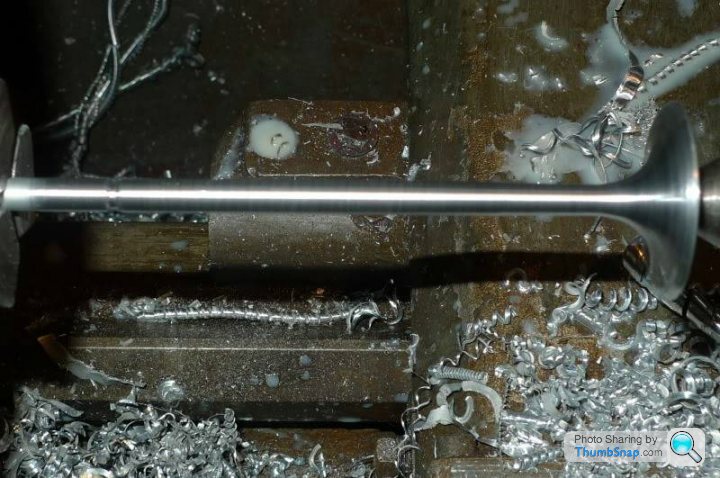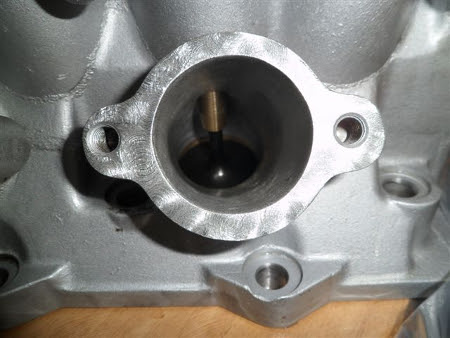Discussion
Cams currently give 13.5mm lift.. Which is where it starts to plateau for flow.. 13-15mm only gives an extra 2cfm @10" head. If you take the valve out you gain 20cfm.
I have been told the back of the valve is too flat and a poor design for higher lift.. So trying to see if it would be worth finding some new valves with a better shape or back cutting the current ones..
I have been told the back of the valve is too flat and a poor design for higher lift.. So trying to see if it would be worth finding some new valves with a better shape or back cutting the current ones..
Edited by Jhonno on Saturday 14th July 11:44
Jhonno said:
Cams currently give 13.5mm lift.. Which is where it starts to plateau for flow.. 13-15mm only gives an extra 2cfm @10" head. If you take the valve out you gain 19cfm.
I have been told the back of the valve is too flat and a poor design for higher lift.. So trying to see if it would be worth finding some new valves with a better shape or back cutting the current ones..
We call port flow with no valve in it 'BPF' (bare port flow) and a lot of people don't seem to check it or at least discuss it which I always think is missing a trick because it does show you something. If your BPF is 200cfm then with the valve in and at max lift a figure of circa 195 is showing it's a good combo. If there is a big difference then your port is too big or the valve too small. Or indeed wrong shape, perhaps.I have been told the back of the valve is too flat and a poor design for higher lift.. So trying to see if it would be worth finding some new valves with a better shape or back cutting the current ones..
As you infer you can then go on to spec your cam from this. I see a lot of ex cams which lift to 12mm or so when the port stopped flowing at 9 - 10mm, it isn't just a waste, it's often a power loss and for more than one reason.
Valve shape usually matches port shape. An old side sidedraft likes a flat 'penny on a stick' style valve, whereas a more modern down draft works well with a tulip style. Personally I never bought valves for testing, I just made them from aluminium.

That one ^^ was made into a PD valve, this is rifle drilled down the stem and then a hole drilled across from the seat to meet it. What you do then is to connect a tube to the end of the valve when it's mounted in the head on the flow bench and take measurements as the valve is rotated 360' like the hand of a clock. You then plot this on paper and it shows where the port is busy or lazy and you port accordingly.
Whether your ports are too big for the valves or the valves the wrong shape is anyone's guess, i'd wager 60/40.
A very open ended question...and the only answer is for you to test on your setup, with whatever valve diameter and head setup you have, at the lifts you intend to use.
As for the back of the valve being too flat ?
Have you looked at many competition style inlet valves ? They're almost all quite flat on the back.
As for the back of the valve being too flat ?
Have you looked at many competition style inlet valves ? They're almost all quite flat on the back.
Mignon said:
I bet that flow specialist guy Pumaracing would have known the answers but some knob end banned him.

Yeah big shame he isn't still about... I've really enjoyed reading many of the threads he has been involved in! Massively informative and interesting. It is probably his fault I am being so anal about this though..
Edited by Jhonno on Saturday 14th July 11:45
So, it was originally quite a generic question, as I thought there might be a fairly generic answer, but as always with engines, it isn't necessarily so..
The engine is a high revving flat plane V8, 4474cc, 2v heads, making ~90-100bhp/L.. I've done the maths (based on one of Pumaracing's old threads) and IMO the ports and the valves are fairly well matched in size, the ports have been flowed not enlarged. Ports are 39mm, valves are 45mm. A good factory engine is 400-420bhp.
Here are the flow figures before and after @10"

The engine is a high revving flat plane V8, 4474cc, 2v heads, making ~90-100bhp/L.. I've done the maths (based on one of Pumaracing's old threads) and IMO the ports and the valves are fairly well matched in size, the ports have been flowed not enlarged. Ports are 39mm, valves are 45mm. A good factory engine is 400-420bhp.
Here are the flow figures before and after @10"

stevieturbo said:
A very open ended question...and the only answer is for you to test on your setup, with whatever valve diameter and head setup you have, at the lifts you intend to use.
As for the back of the valve being too flat ?
Have you looked at many competition style inlet valves ? They're almost all quite flat on the back.
I was intending to used 13.5-14mm lift, with some extra duration.. As for the back of the valve being too flat ?
Have you looked at many competition style inlet valves ? They're almost all quite flat on the back.
I can only go by what the head shop says, and I am paying him for his knowledge. He looked at the heads and one of his first comments was the poor shape of the back of the valve for higher lift.
Jhonno said:
I can only go by what the head shop says, and I am paying him for his knowledge. He looked at the heads and one of his first comments was the poor shape of the back of the valve for higher lift.
Well he's wrong. As anyone who has done extensive flow testing do know it is indisputable that tulip shaped valves work very badly in horizontal ports because they block the flow skipping across the shortside of the port which is why the penny on a stick shape works so well in Minis, MGBs, Ford Pintos etc. However the reverse is not true. A flat back valve also works as a well as anything else in a steeply downdraught port.The usual reason why a port flows a lot more without the valve in it is because of chamber shrouding. Nothing to do with the shape of the valve itself. A photo of the chamber side of the head would be helpful.
227bhp said:
As you infer you can then go on to spec your cam from this. I see a lot of ex cams which lift to 12mm or so when the port stopped flowing at 9 - 10mm, it isn't just a waste, it's often a power loss and for more than one reason.
Going back to this, looking at my flow figures.. I take it that even adding 0.5mm of lift won't benefit the engine? Maybe just some extra duration instead?Kccv23highliftcam said:
How did the engine run before though, was it tractable and driveable?? Adding bits of cam timing here and there could end up being more trouble that it's worth in the long run...
It was OK.. These engines often seem to run out of puff a bit at the top end, would be good to get it to hold on another 500rpm or so. Same as most OEM spec'd engines tbh. I don't think adding a bit of duration would ruin it. I'd rather do it now when the engine is in bits. Going by what I have seen, something around 280 duration would make a decent "fast road" spec.. Gassing Station | Engines & Drivetrain | Top of Page | What's New | My Stuff







